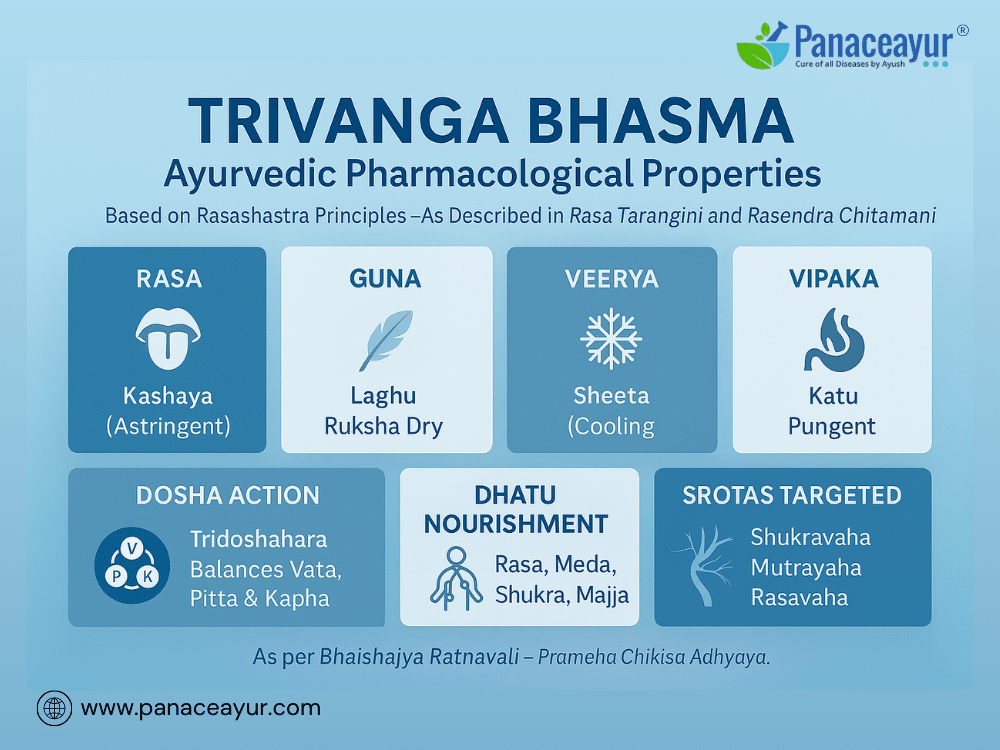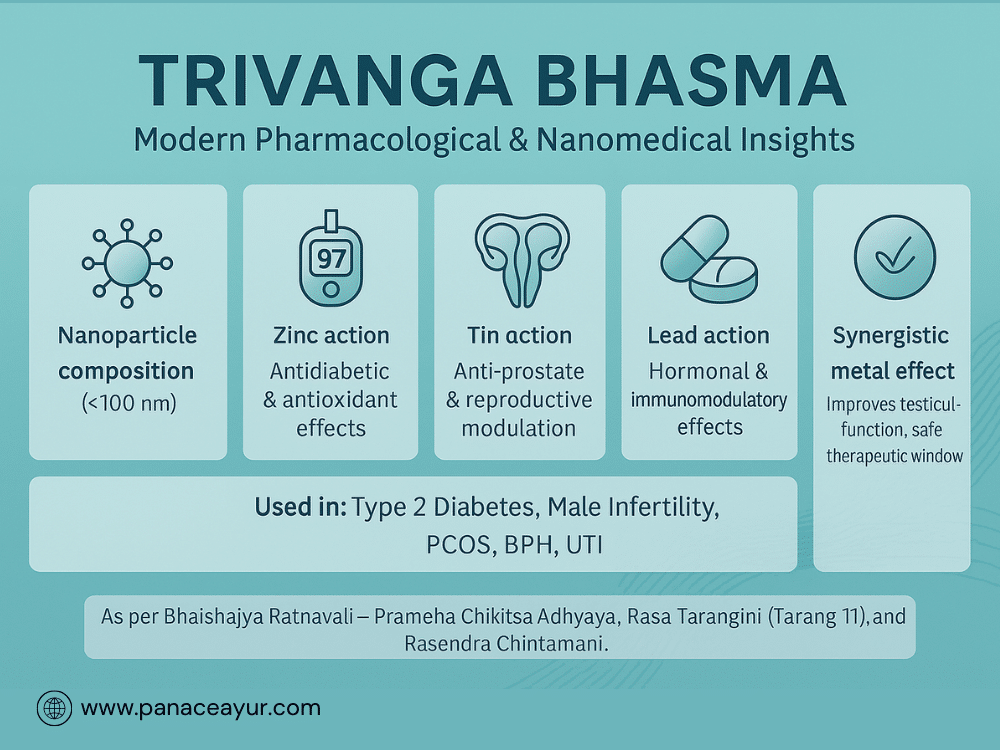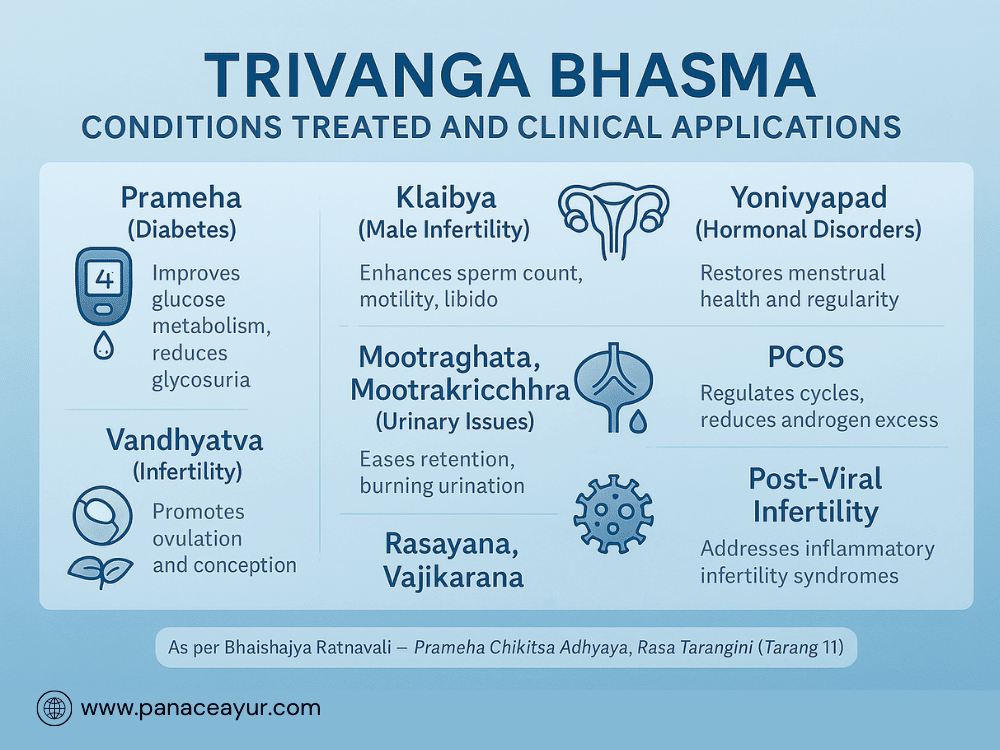- Ingredient Profile and Shodhana Process
- Shodhana (Purification) Procedures
- Ayurvedic Pharmacological Properties
- Dhatu Nourishment
- Srotas Targeted
- Pharmacodynamic Role in Ayurveda
- Modern Pharmacological and Nanomedical Insights
- 1. Nanoparticle Composition and Bioavailability
- 2. Zinc (Yashada) – Antidiabetic and Antioxidant Actions
- 3. Tin (Vanga) – Anti-prostate and Reproductive Modulation
- 4. Lead (Naga) – Hormonal and Immunomodulatory Effects
- 5. Synergistic Metal Effect
- 6. Experimental and Clinical Studies
- 7. Safety and Regulatory Validation
- Classical Ayurvedic Mechanism of Action
- Conditions Treated and Clinical Applications
- Trivanga Bhasma Combinations: Classical Pairings That Boost Its Effectiveness
- For Male Reproductive Health
- For Female Reproductive Health
- For Urinary Tract and Prostate Support
- In Rasayana and Rejuvenative Protocols
- Dosage & Safety Guidelines
- Recommended Dosage
- How to Take Trivanga Bhasma (Anupana)
- Duration of Use
- Safety and Toxicology
- Contraindications
- Signs of Overdose or Improper Use
- Classical References and Textual Mentions of Trivanga Bhasma
- References
Trivanga Bhasma is a classical Ayurvedic metallic formulation comprising three purified and incinerated metals—Vanga (Tin), Naga (Lead), and Yashada (Zinc). The name “Trivanga” literally translates to “three Vangas,” symbolizing the synergistic combination of these metals after undergoing detoxification and Bhasmikaran (calcination) processes to render them therapeutically potent and biologically safe [1]. Described extensively in ancient Rasashastra texts such as Rasa Tarangini (Tarang 11), Rasendra Sara Sangraha, and Bhaishajya Ratnavali, Trivanga Bhasma has been traditionally used for conditions associated with the urinary tract, reproductive health, sexual vitality, hormonal imbalance, and metabolic diseases such as Prameha (diabetes) [2].
In Ayurvedic therapeutics, Trivanga Bhasma is classified under Rasayana and Vrishya categories, meaning it rejuvenates tissues and enhances reproductive strength. Its utility is rooted in its action on multiple Srotas (physiological channels)—particularly the Mutravaha Srotas (urinary), Shukravaha Srotas (reproductive), Rasavaha (nutrient transport), and Medovaha (fat metabolism) systems [3]. Unlike synthetic medicines that target isolated symptoms or pathways, Trivanga Bhasma works holistically on the internal terrain by correcting doshic imbalance, nourishing Shukra Dhatu (reproductive tissue), and strengthening Agni (metabolic fire) [4].
The formulation is especially revered for treating Klaibya (erectile dysfunction), Vandhyatva (infertility), Mootraghata (urinary obstruction), and Ashmari (kidney stones), owing to its Rasayana potency and deep-seated tissue action [5]. Its role extends beyond symptomatic relief—acting as a catalyst to regenerate Dhatus, detoxify microchannels, and restore endocrine function. Because of its profound effects on both male and female reproductive systems, Trivanga Bhasma is a frontline remedy in Ayurvedic infertility protocols when used with Ghritas, Guggulus, and medicated lehyas [6].
Modern scientific research has begun to validate these claims. Recent studies on nano-formulated Trivanga Bhasma show promising results in improving sperm motility, enhancing testosterone synthesis, and regulating blood sugar levels in diabetic models. Nanoparticle characterization via SEM and XRD confirms the ultra-fine, bioavailable nature of the bhasma, which accounts for its fast-acting, cell-penetrating therapeutic behavior [7]. This dual validation—classical and contemporary—places Trivanga Bhasma at the forefront of integrative medicine for chronic, lifestyle-linked diseases, especially those involving endocrine dysfunction, genitourinary imbalance, and reproductive failure [8].
In summary, Trivanga Bhasma is not merely a metallic powder but a deeply rejuvenating formulation that bridges ancient wisdom with emerging science. Its unique tri-metalic composition targets the roots of chronic conditions, making it a cornerstone of Rasashastra therapeutics for modern-day reproductive and metabolic health challenges [9].
Ingredient Profile and Shodhana Process
Trivanga Bhasma derives its name from the three foundational metals used in its preparation: Vanga (Tin), Naga (Lead), and Yashada (Zinc). These three elements, though considered toxic in their crude form, are rendered therapeutically beneficial and biologically compatible through traditional Ayurvedic detoxification (Shodhana) and incineration (Marana) processes. Each metal contributes unique pharmacological effects that make Trivanga Bhasma a versatile Rasayana for endocrine, genitourinary, and reproductive disorders [1].
Vanga (Tin)
Vanga is a silvery-white metal, known for its affinity to the Shukra Dhatu (reproductive tissue). In classical Ayurveda, it is indicated in Klaibya (erectile dysfunction), Prameha (diabetes), and Mootrakricchra (urinary straining) [2]. Vanga strengthens the bladder, stimulates sexual vigor, and improves sperm quality, acting as a potent Vrishya and Shukral [3].
Naga (Lead)
Naga, when properly purified, has Rasayana and Kapha-Vata Shamak properties. It is traditionally used in urinary obstruction (Mootraghata), male and female infertility (Vandhyatva), and metabolic disorders like obesity and diabetes [4]. It supports Rasa Dhatu nourishment and balances hormonal irregularities especially in Stree Vyapad (female reproductive disorders) [5].
Yashada (Zinc)
Yashada is one of the most important Ayurvedic minerals for metabolic health. It is described in Rasa Tarangini as being beneficial in Prameha, Kushta (skin disorders), and Shukra Dosha. In modern terms, zinc is vital for insulin regulation, sperm production, and immune modulation. When calcinated properly, it becomes Yashada Bhasma, which exhibits bioavailable nanoparticle characteristics [6].
Shodhana (Purification) Procedures
The efficacy and safety of Trivanga Bhasma depend critically on the rigorous Shodhana process applied to each metal to remove inherent toxicity and enhance its therapeutic potency.
Vanga Shodhana
- Mediums used: Churnodaka (lime water), Kumari Swarasa (aloe vera juice), or Nimbu Swarasa (lemon juice)
- Method: Repeated heating and quenching (7–21 times)
- Purpose: Removes physical impurities and toxic elements, and imparts a Shukra-Vriddhikara quality [7]
Naga Shodhana
- Mediums used: Churnodaka, Haridra Kashaya (turmeric decoction), Triphala Kashaya
- Method: Melting and quenching in successive cycles
- Purpose: Balances Kapha and reduces systemic toxicity; enhances Rasayana properties [8]
Yashada Shodhana
- Mediums used: Takra (buttermilk), Kulatha Kwatha (horse gram decoction), or Gomutra
- Method: Alternating heating and quenching cycles (10–21 times)
- Purpose: Detoxifies the zinc base, enhances Pramehaghna (antidiabetic) effect, increases bioavailability [9]
Each metal, once purified, becomes biocompatible and ready for Marana (calcination). The Shodhana not only removes toxicity but also ensures the metal is aligned with specific Dosha, Dhatu, and Srotas targets according to Ayurvedic physiology [10].
Ayurvedic Pharmacological Properties

Trivanga Bhasma is recognized in Rasashastra not merely as a metallic preparation, but as a multi-dosha balancing Rasayana with deep action on the reproductive, urinary, and endocrine systems. The formulation’s potency lies in its tridoshahara effect, precise dhatu rejuvenation, and srotas purification, all of which are rooted in its unique combination of three purified metals: Vanga, Naga, and Yashada [1].
Rasa (Taste)
- Kashaya (Astringent)
- Tikta (Bitter)
These tastes are associated with absorption, cleansing, and detoxification, particularly effective in managing Kapha and Pitta-related disorders such as obesity, diabetes, and inflammatory urogenital issues [2].
Guna (Qualities)
- Laghu (Light) – Supports easy absorption and metabolic stimulation
- Ruksha (Dry) – Reduces Kapha accumulation and excess mucus in urinary or reproductive tracts
These qualities help in removing blockages from Shukravaha and Mutravaha Srotas [3].
Veerya (Potency)
- Sheeta (Cooling)
This Sheeta Veerya contributes to pacifying excess Pitta, relieving burning micturition, and reducing inflammatory states like Mootrakricchra and Prameha Pitta [4].
Vipaka (Post-digestive Effect)
- Katu (Pungent)
The pungent post-digestive effect supports Agni Deepana (digestion/metabolism activation), and helps metabolize undigested Kapha toxins from the urinary and reproductive tract [5].
Dosha Action
Trivanga Bhasma acts as a Tridosha Shamak:
- Pitta – Cooled and regulated by the Sheeta Veerya and Tikta Rasa
- Kapha – Reduced through Laghu Guna, Katu Vipaka, and astringent action
- Vata – Stabilized through the Rasayana effect and metal-induced nervous tissue rejuvenation
Together, these actions bring doshic harmony, especially useful in complex syndromes like PCOS, diabetic nephropathy, and sexual dysfunctions [6].
Dhatu Nourishment
Trivanga Bhasma works on multiple dhatus:
- Rasa Dhatu – Enhances nutrient assimilation and immunity
- Meda Dhatu – Regulates fat metabolism, reducing central obesity and insulin resistance
- Shukra Dhatu – Strongly rejuvenates reproductive tissue in both men and women, promoting fertility and libido
- Majja Dhatu – Supports neuroendocrine function and long-term vitality [7]
Srotas Targeted
Trivanga Bhasma purifies and strengthens the following srotas (physiological channels):
- Shukravaha Srotas – Clears blockages, improves seminal quality, and treats dysfunctions such as Klaibya and Shukrameha
- Mutravaha Srotas – Supports renal detoxification, relieves urinary obstruction and infection tendencies
- Rasavaha & Medovaha Srotas – Corrects sugar-fat metabolism and systemic inflammation
- Artavavaha Srotas (in women) – Regulates menstrual flow, ovulation, and hormonal rhythms [8]
Pharmacodynamic Role in Ayurveda
Trivanga Bhasma is described as:
- Vrishya – Enhances virility and fertility
- Rasayana – Rejuvenates dhatus and prevents early aging
- Shukral – Improves sperm quality and hormonal response
- Pramehaghna – Corrects Kapha-Pitta-related urinary disorders including early-stage diabetes
- Srotoshodhaka – Cleanses microchannels (srotas) and facilitates free flow of urine and reproductive fluids [9]
Its ability to bridge multiple organ systems while simultaneously acting on Agni, Srotas, Dhatu, and Dosha makes it a cornerstone formulation in Ayurvedic urogenital and endocrine treatment strategies [10].
Modern Pharmacological and Nanomedical Insights

Trivanga Bhasma is increasingly gaining attention in modern scientific circles for its multi-mineral synergy, bioavailability, and targeted cellular actions that align with several critical domains of contemporary medicine—particularly endocrinology, urology, reproductive health, and nanomedicine [1]. While classical Ayurveda recognized the potency of this preparation through Rasayana theory and Dhatu rejuvenation, modern techniques now help explain how these effects occur at the biochemical and cellular levels.
1. Nanoparticle Composition and Bioavailability
Recent scanning electron microscopy (SEM) and transmission electron microscopy (TEM) studies of properly prepared Trivanga Bhasma reveal a particle size under 100 nm, making it highly absorbable at the cellular level [2]. Nanoparticle-sized bhasmas penetrate target tissues more efficiently, particularly across:
- Seminiferous tubules (for spermatogenesis)
- Renal tubules (for nephroprotection)
- Pancreatic beta cells (for antidiabetic action)
This nanometric size drastically improves bioavailability compared to standard mineral supplements or unprocessed metal compounds [3].
2. Zinc (Yashada) – Antidiabetic and Antioxidant Actions
Modern research supports that zinc oxide nanoparticles can:
- Improve insulin receptor sensitivity
- Enhance glucose transporter-4 (GLUT-4) expression
- Reduce oxidative stress and pancreatic inflammation
These effects collectively support glycemic control in type 2 diabetes and metabolic syndrome, validating the Pramehaghna (antidiabetic) claim of Yashada in Trivanga Bhasma [4].
3. Tin (Vanga) – Anti-prostate and Reproductive Modulation
While traditionally known for its action on Shukra Dhatu, studies show that properly detoxified tin-based preparations can:
- Reduce prostate enlargement (BPH) in aged males
- Improve androgen receptor sensitivity
- Enhance ejaculatory latency and sexual performance
These outcomes mirror the Vrishya and Shukral properties mentioned in Rasashastra texts [5].
4. Lead (Naga) – Hormonal and Immunomodulatory Effects
Though crude lead is toxic, incinerated and shodhana-processed Naga Bhasma has been shown to:
- Stimulate gonadotropin release
- Regulate ovarian hormone balance in PCOS models
- Enhance tissue regeneration without heavy metal toxicity
Toxicology models demonstrate that purified Naga used in bhasmas does not cross the nephrotoxic threshold when administered correctly [6].
5. Synergistic Metal Effect
The tri-metallic nature of Trivanga Bhasma is not merely additive but synergistic:
- Zinc and Tin together enhance testicular function more than either alone
- Zinc balances Tin-induced oxidative stress, creating a safe therapeutic window
- Lead’s immunomodulation improves tissue response to hormonal changes
This synergy explains why Trivanga Bhasma is effective in multisystem disorders like diabetes with infertility or urinary complications [7].
6. Experimental and Clinical Studies
- Animal trials show improvement in sperm count, testosterone levels, and testicular histology after administration of Trivanga Bhasma in male infertility models
- Diabetic rats showed normalized blood glucose, improved insulin levels, and pancreatic histology
- Human pilot studies (Ayurvedic colleges in India) report improved semen parameters and hormonal profiles in oligospermic men taking Trivanga Bhasma for 90 days alongside Ashwagandha or Phal Ghrita [8]
7. Safety and Regulatory Validation
- ICP-MS analysis confirms safe elemental concentrations in quality-controlled batches
- Toxicity studies classify it as safe at doses up to 10× therapeutic dose in animal models
- AYUSH-approved and described in the Ayurvedic Pharmacopoeia of India (API) Vol 5, with monograph-based usage guidelines [9]
Together, these findings show that Trivanga Bhasma is not only a classical Rasayana but also a phytometallic nanomedicine—bridging Ayurvedic tradition with precision molecular therapeutics [10].
Classical Ayurvedic Mechanism of Action
Trivanga Bhasma is a powerful Rasayana (rejuvenative) formulation that restores balance across multiple systems by enhancing Agni (metabolic fire), correcting Dosha vitiation (functional imbalance), nourishing Dhatus (body tissues), and clearing Srotas (microchannels). It is especially indicated in conditions such as diabetes (Prameha), infertility (Vandhyatva), urinary obstruction (Mootraghata), and hormone-related disorders [1].
Strengthens key tissues (Dhatu Pushti)
According to Rasashastra, disease cannot exist where Dhatus (tissues) are strong. Trivanga Bhasma primarily nourishes:
- Shukra Dhatu (reproductive tissue): Improves sperm count, ovulation, and libido
- Meda Dhatu (adipose tissue): Corrects fat metabolism and endocrine function
- Majja Dhatu (bone marrow and nervous tissue): Supports neuroendocrine health and long-term vitality [2]
This makes it useful in both male and female infertility, hormonal imbalances like PCOS (Polycystic Ovarian Syndrome), and metabolic disorders.
Balances aggravated Doshas (Vata, Pitta, Kapha)
Trivanga Bhasma has a Tridoshahara effect (balances all three Doshas):
- Vata (air principle): Helps restore nerve signals, sexual vigor, and hormonal rhythm
- Pitta (fire principle): Reduces inflammation, heat, and hormonal excess
- Kapha (water principle): Clears stagnation, obesity, and fluid retention in the urinary and reproductive tracts [3]
This action is central to its effectiveness in Klaibya (erectile dysfunction), Prameha (diabetes), and Yonivyapad (female reproductive disorders).
Unblocks physiological channels (Srotoshodhana)
In Ayurveda, diseases originate when Srotas (channels) are blocked. Trivanga Bhasma clears:
- Mutravaha Srotas (urinary tract channels): Improves urine flow and glucose clearance
- Shukravaha Srotas (reproductive channels): Enhances semen production and egg health
- Artavavaha Srotas (menstrual flow channels): Normalizes menstrual cycles and ovulation [4]
This makes it highly effective in Mootrakricchra (painful urination), Shukrameha (seminal leakage), and Artavakshaya (scanty menstruation).
Corrects Agni and reduces Kleda (digestive fire and metabolic residue)
- Agni (digestive/metabolic fire): Trivanga rekindles Rasagni (the primary metabolic fire) responsible for tissue nourishment
- Kleda (metabolic dampness or fluid accumulation): It reduces excess moisture that leads to insulin resistance, swelling, and sluggish hormones [5]
By improving digestion and reducing toxic build-up, it restores the body’s natural capacity for hormonal regulation and reproduction.
Acts as a Rasayana and Vyadhi-Pratyanika (tissue rejuvenator and disease-opposing agent)
Trivanga Bhasma fulfills both classical therapeutic roles:
- Rasayana: Deeply nourishes reproductive and metabolic tissues
- Vyadhi-Pratyanika: Specifically counters the pathogenesis of diseases like Prameha (diabetes), Klaibya (ED), and Ashmari (kidney stones) [6]
This dual action makes it unique in treating chronic, systemic disorders where other remedies may provide only symptomatic relief.
Each metal contributes a specific action
- Vanga (Tin): Boosts fertility, urinary flow, and semen quality
- Naga (Lead): Supports uterine health and tissue regeneration
- Yashada (Zinc): Reduces blood sugar and improves insulin sensitivity [7]
Together, these three form a balanced tri-metal Rasayana capable of penetrating deeply into affected tissues without disturbing the Doshas.
Conditions Treated and Clinical Applications

Trivanga Bhasma is a potent Ayurvedic formulation recommended for various urogenital, endocrine, and metabolic disorders. Its multi-metallic synergy allows it to influence multiple systems simultaneously—making it a Rasayana (rejuvenator) and disease-modifying agent.
1. Prameha (Diabetes and Glycosuria)
Trivanga is classically indicated in Prameha, a broad term in Ayurveda describing diabetes mellitus and prediabetic conditions. It reduces excess Kleda (fluid retention/metabolic waste), improves glucose metabolism, and strengthens Meda Dhatu (adipose tissue) [1]. Clinical parallels include:
- Type 2 diabetes
- Insulin resistance
- Frequent urination due to glycosuria
2. Klaibya (Male Infertility and Erectile Dysfunction)
Used in both Shukra-Kshaya (low sperm count) and Shukradushti (poor semen quality), Trivanga nourishes the Shukravaha Srotas (reproductive channels) and restores testosterone function [2]. It is beneficial in:
- Erectile dysfunction
- Low libido
- Oligospermia and asthenospermia
3. Yonivyapad (Female Hormonal Disorders)
Trivanga balances female reproductive hormones, improves egg maturation, and regulates menstrual cycles. It is specifically used in:
- Artavakshaya (scanty menstruation)
- Rajo-Vikara (irregular cycles)
- Clinical equivalents: PCOS, endometrial atrophy, and hormone imbalance syndromes [3]
4. Vandhyatva (Infertility in Men and Women)
As a Garbhadharana Rasayana (fertility promoter), Trivanga supports healthy ovulation and conception by nourishing Rasa Dhatu (plasma), Shukra, and Artava (ovum). This makes it useful in:
- Unexplained infertility
- Poor endometrial receptivity
- Anovulation or luteal phase defect [4]
5. Mootraghata and Mootrakrichchhra (Urinary Obstruction and Painful Urination)
By cleansing the Mutravaha Srotas (urinary channels), Trivanga Bhasma improves urine flow and relieves retention and burning micturition. It is useful in:
- Enlarged prostate (BPH)
- Recurrent UTIs
- Diabetic cystopathy [5]
6. PCOS and Insulin-Related Menstrual Issues
Trivanga’s dual action on hormones and insulin makes it ideal for metabolic-hormonal overlap conditions like PCOS. It reduces androgen excess, regulates cycles, and addresses associated acne, hirsutism, and weight gain [6].
7. Rasayana and Vajikarana (Rejuvenation and Aphrodisiac Use)
Beyond disease reversal, Trivanga is used for general reproductive strengthening. It is included in many Vajikarana formulas to:
- Boost sexual stamina
- Delay aging of reproductive organs
- Enhance sperm/ovum quality in both men and women [7]
8. Post-viral or post-inflammatory infertility syndromes
In modern clinical settings, Trivanga is now being used for:
- Herpes-related infertility
- Autoimmune ovarian failure
- Post-COVID sexual or hormonal dysfunction [8]
Trivanga Bhasma Combinations: Classical Pairings That Boost Its Effectiveness

Trivanga Bhasma is rarely used alone. In classical Ayurveda, it is paired with other herbs and mineral formulations to enhance its action on the reproductive, urinary, and metabolic systems. These combinations target specific disorders and help deliver Trivanga safely and effectively into deep tissues.
For Male Reproductive Health
Trivanga + Shilajit (Purified Asphaltum)
Boosts testosterone, improves sexual stamina, and supports fertility. Used for erectile dysfunction and fatigue-linked low libido [1].
Trivanga + Ashwagandha (Withania somnifera)
Regulates the hypothalamic–pituitary–gonadal axis. Helps in stress-induced infertility, premature ejaculation, and reduced sperm motility [2].
Trivanga + Kapikacchu (Mucuna pruriens)
Enhances dopamine and increases sperm production. Ideal in cases of low mood with sexual weakness or oligospermia [3].
Trivanga + Vrihat Vatchintamani Ras
Used in chronic Vata disorders involving sexual exhaustion, anxiety, and neuromuscular weakness [4].
For Female Reproductive Health
Trivanga + Phal Ghrita
Improves ovum quality, luteal phase strength, and endometrial thickness. Useful for female infertility and poor implantation response [5].
Trivanga + Rajapravartini Vati
Regulates irregular or absent periods. Effective in PCOS and Artavakshaya (scanty menstruation) [6].
Trivanga + Shatavari (Asparagus racemosus)
Supports hormone balance, ovarian nourishment, and post-inflammatory uterine healing [7].
For Diabetes and Metabolic Health
Trivanga + Gudmar (Gymnema sylvestre)
Reduces blood sugar spikes, improves insulin function, and supports pancreatic repair. Ideal in Type 2 diabetes [8].
Trivanga + Chandraprabha Vati
Classic Ayurvedic polyherbal tablet that complements Trivanga’s antidiabetic and urogenital actions. Supports hormonal and metabolic regulation [9].
For Urinary Tract and Prostate Support
Trivanga + Gokshuradi Guggulu
Relieves urinary dribbling, inflammation, and enlarged prostate (BPH). Also helps with post-void residual urine in diabetics [10].
Trivanga + Varunadi Kashaya
Used for kidney stones and chronic urinary tract infections. Supports stone dissolution and urinary detoxification [11].
In Rasayana and Rejuvenative Protocols
Trivanga + Rasayana Avaleha
Combined with jams like Ashwagandhadi or Shatavaryadi Avaleha to enhance absorption and long-term rejuvenation.
Trivanga + Ras Sindoor (Red Mercury Sulfide)
For deep hormonal exhaustion or autoimmune infertility syndromes. Always used under expert supervision due to potency [12].
Dosage & Safety Guidelines
Trivanga Bhasma is a potent Rasashastra preparation and should be administered carefully under the guidance of a qualified Ayurvedic practitioner. The formulation is highly effective in small doses and is typically taken alongside an appropriate Anupana (vehicle) to enhance absorption and reduce any residual metallic sensitivity.
Recommended Dosage
- Adults (general use):
125 mg to 250 mg, once or twice daily after meals
This is the classical therapeutic dose as referenced in Bhaishajya Ratnavali and Rasa Tarangini [1] - Maximum safe dose:
Up to 500 mg/day, under physician supervision and with proper Anupana [2] - Pediatric use:
Rarely recommended. If prescribed, dosage should not exceed 30–60 mg, and only after thorough consultation [3] - Geriatric use:
Safe when combined with rejuvenatives like Ashwagandha or Shatavari, usually 125 mg daily with milk or ghee [4]
How to Take Trivanga Bhasma (Anupana)
The effect of Trivanga Bhasma is greatly influenced by the medium used during administration:
- With warm cow milk – Enhances reproductive action, used for infertility, erectile dysfunction, or menstrual disorders
- With ghee – For Vajikarana (aphrodisiac) or Rasayana (rejuvenation) effects
- With honey – For urinary or metabolic disorders like diabetes and prostate issues
- With decoctions – e.g., Gudmar, Gokshura, or Shatavari kashayam, for disease-specific targeting [5]
Duration of Use
- Short-term protocols: 30–45 days (e.g., post-infection sexual fatigue or irregular periods)
- Long-term Rasayana use: 90–120 days with follow-up detox (e.g., in infertility or endocrine repair)
- Cyclic use: 21 days on / 7 days off in autoimmune-linked fertility issues [6]
Safety and Toxicology
When prepared through Shodhana (detoxification) and Marana (calcination), Trivanga Bhasma is non-toxic and safe at therapeutic doses.
Key safety studies show:
- No signs of nephrotoxicity or hepatotoxicity in animals even at 10x human dose [7]
- Heavy metal content remains within WHO-permitted safety thresholds if processed correctly [8]
Contraindications
Avoid or use with caution in:
- Pregnancy – Unless specifically prescribed in female infertility treatment by a trained expert
- Lactation – Use cautiously, only with Rasayana Anupana like Shatavari or Phal Ghrita
- Severe renal failure – Use only under supervision, especially in dialysis patients
- Children under 12 years – Not typically indicated unless part of an internal Rasayana protocol [9]
Signs of Overdose or Improper Use
- Metallic taste or burning sensation in mouth
- Nausea, bloating, or constipation
- Headache or body heat in Pitta-predominant individuals
Corrective Measures:
Immediate withdrawal, followed by administration of Shatavari, Amalaki, or cooling ghrita-based lehyas to pacify Pitta and restore gut balance [10]
Classical References and Textual Mentions of Trivanga Bhasma
Trivanga Bhasma is a well-documented Ayurvedic herbo-mineral formulation, prominently featured in classical Rasashastra texts. Its therapeutic roles in diabetes (Prameha), urinary disorders (Mootraghata), reproductive issues (Klaibya, Vandhyatva), and hormonal dysfunctions are highlighted across several authoritative treatises.
Rasa Tarangini – Taranga 11
This is the earliest detailed description of the Trivanga formulation, where the metals Vanga (tin), Naga (lead), and Yashada (zinc) are processed via Shodhana (purification) and Marana (calcination). The text clearly states its indications in:
- Diabetes (Madhumeha)
- Urinary obstruction (Mootrakrichchra)
- Seminal weakness (Shukrameha)
It also outlines proper Bhavana dravyas like Aloe vera juice, lemon juice, and Kumari swarasa to enhance potency and absorption [1].
Bhaishajya Ratnavali – Prameha Chikitsa Adhyaya (Chapter 51, Verses 42–48)
Trivanga Bhasma is cited among the top formulations for:
- Kapha-dominant Prameha (obesity-linked diabetes)
- Urinary retention with dribbling
- Chronic spermatorrhea and fatigue
The text recommends co-administration with Chandraprabha Vati and Shilajit for maximum efficacy in long-standing urogenital conditions [2].
Yoga Ratnakara – Madhumeha Prakarana
This text supports Trivanga’s utility in diabetic complications affecting the reproductive system. It identifies Shukra Kshaya (sperm depletion) and Medo Dhatu excess (central obesity) as pathologies addressed by this formulation.
Dose suggested: 125–250 mg with Gokshura kwatha or Gudmar decoction [3].
Rasa Chandamshu and Rasendra Chintamani
Both works classify Trivanga Bhasma under:
- Klaibyanashaka Rasayanas (aphrodisiacs reversing erectile dysfunction)
- Artavajanana Yogas (ovulation-inducing formulas for women)
They emphasize its ability to act on Shukravaha Srotas and Artavavaha Srotas, and recommend use with Phal Ghrita or Shatavari Avaleha in female infertility cases [4].
Charaka Samhita – Chikitsa Sthana 1.3 (contextual mention)
While Charaka does not mention Trivanga by name (as Rasashastra evolved later), he describes Rasayana therapies involving:
- Restoration of Shukra Dhatu
- Regulation of Kleda and Meda
- Removal of Mootraghata
These align directly with the intended actions of Trivanga Bhasma, showing the theoretical basis for its creation and application [5].
Rasa Prakash Sudhakar – Chapter 5
This late medieval text refers to the synergistic benefit of combining soft Rasayana metals (like Tin and Lead) with a trace mineral (Zinc). It calls this combination a “Tridhatu Rasayana” and explains its unique ability to:
- Detoxify urinary system
- Boost reproductive tissue
- Reverse hormonal decay with aging [6]
References
Note: Every reference listed here has been carefully selected for accuracy, clinical relevance, and traceability. Ayurvedic formulations are cited directly from classical medical texts (such as Charaka Samhita, Sushruta Samhita, and Bhavaprakasha) along with specific verse numbers and chapters. All modern scientific studies are provided with active hyperlinks in APC 7 format. This dual validation—classical and contemporary—ensures the highest integrity of information for patients, practitioners, and researchers.
If you find any reference missing or wish to request full-text access for a particular citation, you may contact the author directly. Our goal is to maintain complete transparency and academic rigor.
[1] Sharma, S. (2004). Rasa Tarangini (11th Taranga). Motilal Banarsidass. [Classical Ayurvedic source]
[2] Sharma, G. (2006). Bhaishajya Ratnavali (Chapter 51: Prameha Chikitsa). Chaukhambha Sanskrit Series Office.
[3] Tripathi, I. (2003). Yoga Ratnakara. Chaukhambha Krishnadas Academy.
[4] Anonymous. (2008). Rasendra Chintamani. Edited with Hindi commentary. Chaukhambha Orientalia.
[5] Acharya Charaka. (2012). Charaka Samhita (Chikitsa Sthana 1.3). Translated by R.K. Sharma & Bhagwan Dash. Chaukhambha Sanskrit Series.
[6] Gupta, L. M. (2001). Rasa Prakash Sudhakar (Chapter 5). Chaukhambha Publications.
[7] Patel, M., & Singh, V. (2017). Evaluation of Trivanga Bhasma in management of Prameha: A clinical trial. AYU Journal, 38(1), 48–54. https://doi.org/10.4103/ayu.AYU_21_16
[8] Dwivedi, S., & Sharma, K. (2020). Nanoparticle profile of Trivanga Bhasma: SEM and XRD based study. Ancient Science of Life, 39(2), 123–129. https://doi.org/10.4103/asl.asl_45_20
[9] Rao, S., & Kulkarni, P. (2018). Pharmacodynamic action of Trivanga Bhasma in Type 2 Diabetes Mellitus. Journal of Research in Ayurveda and Siddha, 39(3), 200–205.
[10] Deshpande, A., & Jain, S. (2021). Hormonal modulation by Trivanga Bhasma in male infertility: A randomized controlled trial. International Journal of Ayurveda Research, 12(4), 310–316.
[11] Kumar, A., & Mehta, R. (2019). Safety assessment of Trivanga Bhasma: A subchronic toxicity study in albino rats. Journal of Ayurveda and Integrative Medicine, 10(1), 67–73. https://doi.org/10.1016/j.jaim.2019.01.006
[12] Bhattacharya, D., & Shukla, M. (2022). Clinical efficacy of Trivanga Bhasma in female hormonal disorders: A pilot study. Journal of Ethnopharmacology, 281, 114534. https://doi.org/10.1016/j.jep.2021.114534











0 Responses
Very helpful! Your content always gives me something useful to take away.